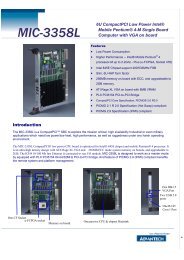industrial wireless book special edition - Networking ...
industrial wireless book special edition - Networking ...
industrial wireless book special edition - Networking ...
You also want an ePaper? Increase the reach of your titles
YUMPU automatically turns print PDFs into web optimized ePapers that Google loves.
I n d u s t r i a l W i r e l e s s<br />
must support the standard built into these<br />
portable devices. 802.11b and 802.11g (Wi-Fi)<br />
are of course the most common. This<br />
technology supports mobile operators while<br />
providing high speed, low latency communications.<br />
Remote SCADA Systems<br />
Utilities extensively use remote SCADA networks<br />
where remote pump stations, tanks, substations<br />
and pipelines are controlled and<br />
monitored from a central site. Wireless is a very<br />
good alternative to leasing phones lines. The<br />
main challenge with remote SCADA is distance<br />
and terrain between the sites. Wireless technologies<br />
that support EtherNet/IP speeds<br />
require unobstructed line-of-sight (LOS) and<br />
adherence to the Fresnel Zone for optimal<br />
performance. Analyzing the terrain and LOS<br />
obstructions is vital in determining the feasibility<br />
of such links. Fortunately, repeater sites<br />
are often available to achieve LOS and many<br />
FHSS radios have store-and-forward repeating<br />
capabilities.<br />
Most EtherNet/IP SCADA systems do not<br />
require fast communications as Explicit<br />
Messaging is used to communicate from the<br />
remote PLCs back to the central plant.<br />
Frequency hopping is often the best choice<br />
here because FHSS offers the longest range due<br />
to excellent receiver sensitivity and support of<br />
the 90 MHz frequency band.<br />
Bandwidth is limited in FHSS systems, so<br />
careful examination of network traffic is<br />
prudent. There is sometimes a temptation to<br />
add in other types of communication (such as<br />
VoIP, surveillance video, Internet connectivity,<br />
etc.) which will quickly exceed the capabilities<br />
Remote Wireless SCADA system using EtherNet/IP<br />
TCP/IP<br />
of an FHSS <strong>wireless</strong> system. IEEE 802.11-based<br />
systems offer the highest speeds for multiple<br />
use remote communications, but are limited in<br />
distance as their receiver sensitivity is lower<br />
and they do not support the 900MHz band.<br />
Wireless for Implicit Messaging<br />
An emerging application for <strong>wireless</strong> is communications<br />
to distributed I/O blocks using<br />
EtherNet/IP. Wireless offers many advantages<br />
in these applications including elimination of<br />
mechanical coupling methods used in moving<br />
systems (e.g. rails, slip rings) and general cost<br />
savings due to reduction of Ethernet infrastructure.<br />
Communication to EtherNet/IP I/O<br />
blocks can also reduce automation costs<br />
The importance of modulation type and channel spacing<br />
Direct Sequence and Orthogonal Frequency offer the fastest spread spectrum data rates as the wide<br />
channel permits transmission of complex modulation schemes. OFDM uses a complex modulation<br />
technique and is capable of high data rates and low latency (the transmission time a packet takes from<br />
one end to the other). OFDM is also significantly more immune to multipath fading, a problem due to<br />
RF reflections that high data rate systems frequently exhibit. (Note that slower speed frequency hopping<br />
systems are relatively immune to multipath).<br />
Direct Sequence and OFDM are the methods used by all popular open Wi-Fi standards today including<br />
IEEE 802.11b, 802.11g (both transmitting in the 2.4GHz band) and 802.11a (transmitting in the 5GHz<br />
band). IEEE 802.11n is nearing ratification at the time this paper was written, and will also incorporate<br />
these techniques. While the wide band modulation offers high speed, it unfortunately is more prone<br />
to noise problems when multiple systems are operating in close proximity. For example,<br />
IEEE802.11b/g has thirteen channels available (eleven channels in North America), but only three<br />
channels don’t overlap.<br />
Non-overlapping 802.11b/g Channels (1, 6 & 11). Due to overlapping channels and the popularity of Wi-Fi systems<br />
in plants, band crowding and RF saturation can lead to poor <strong>wireless</strong> performance<br />
compared to using remote PLCs. Programming<br />
is simpler using I/O instead of remote PLCs<br />
because MSG blocks are not required in the<br />
main controller’s ladder program. But remember<br />
that Implicit Messaging is based on UDP/IP,<br />
not TCP/IP. Wireless networks must be carefully<br />
designed, and the plant RF environment more<br />
closely managed to ensure reliable communications.<br />
Several factors should be carefully considered<br />
before choosing this architecture, including:<br />
l Lack of remote PLC control (intelligence) in<br />
case of communication failure;<br />
l Amount of I/O and required scan times<br />
(network traffic);<br />
l Packet handling ability of <strong>wireless</strong> technology;<br />
l Efficiency of the RF technology with<br />
multicast UDP packets;<br />
l 802.11 clear channel availability.<br />
However if circumstances are right, <strong>wireless</strong><br />
EtherNet/IP I/O can be a significant cost saver<br />
and actually improve system reliability when<br />
correctly implemented, e<strong>special</strong>ly in moving<br />
systems.<br />
Practical implementation<br />
Our company has done much work with<br />
EtherNet/IP and has many successful customer<br />
installations. The following information is<br />
provided only as a guideline towards predicting<br />
<strong>wireless</strong> performance and should not be relied<br />
upon for any other purpose. We always<br />
recommend field testing to confirm <strong>wireless</strong><br />
performance and reliability.<br />
Predicting <strong>wireless</strong> I/O performance. Because<br />
EtherNet/IP I/O messages are scheduled, it is<br />
possible to predict scan time performance over<br />
<strong>industrial</strong> <strong>wireless</strong> systems if the following<br />
conditions are met:<br />
l Packets per second performance of <strong>wireless</strong><br />
technology;<br />
l Wireless behaviour in multipoint systems<br />
(handling of UDP Multicasts);<br />
l Number of CIP connections.<br />
The first step in designing a <strong>wireless</strong><br />
EtherNet/IP system is to calculate the number<br />
of packets per second which determines<br />
minimum <strong>wireless</strong> bandwidth requirements.<br />
Start by counting the number of CIP connections.<br />
To calculate how many connections are<br />
in an I/O system, sum up all direct connections<br />
and rack optimised connections. To<br />
determine how many packets per second the<br />
system will be using, multiply each connection<br />
by two. Two…? This is because each CIP<br />
connection is bi-directional meaning that<br />
during every Requested Packet Interval (RPI),<br />
a produced packet is sent by each end of the<br />
connection.<br />
For example, if there are five direct connections<br />
and two rack-optimised connections (with<br />
six digital modules in each) this equals seven<br />
total CIP Connections, the total number of<br />
packets is then calculated:<br />
20<br />
<strong>industrial</strong> ethernet <strong>book</strong><br />
sponsored by Advantech

















